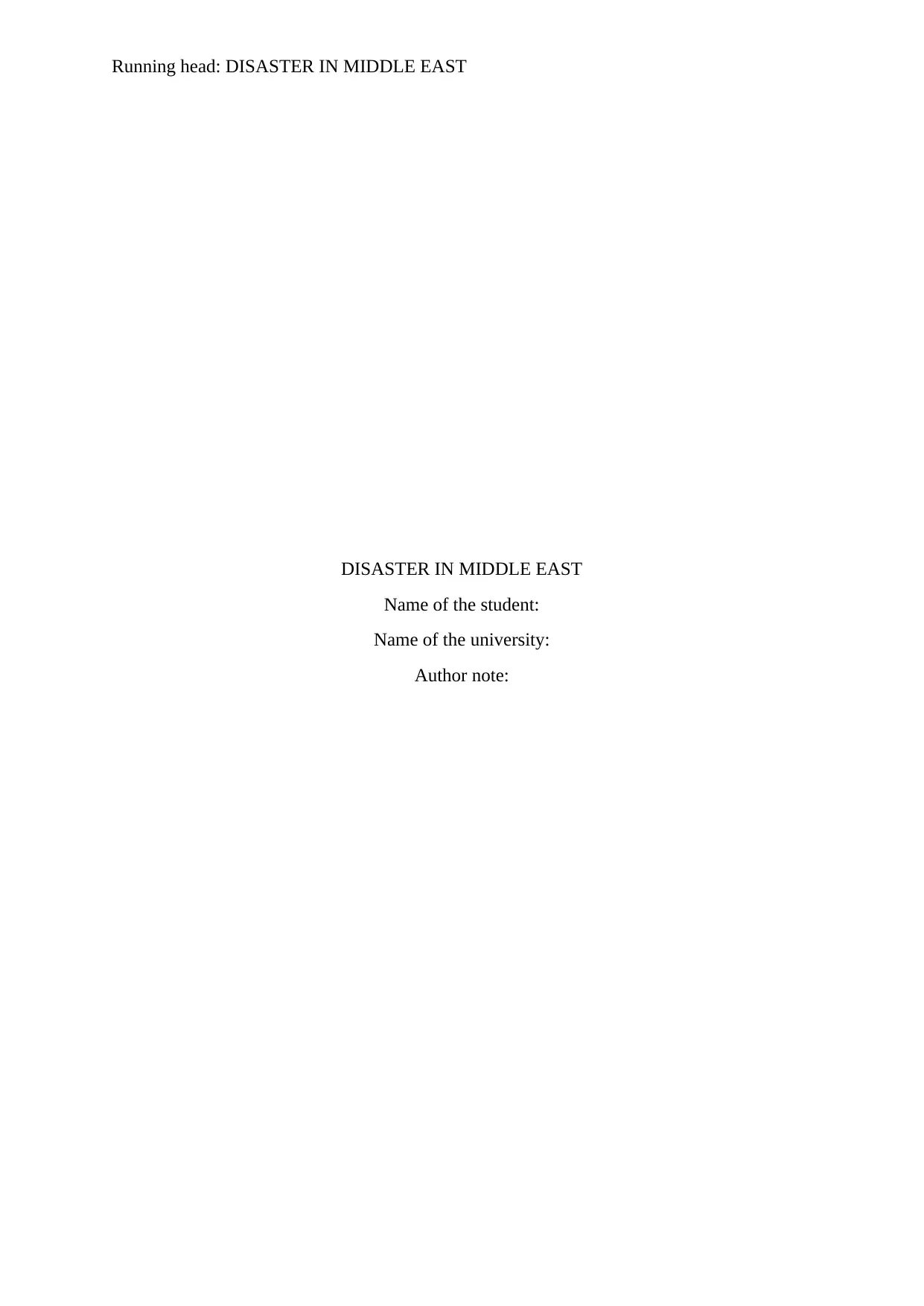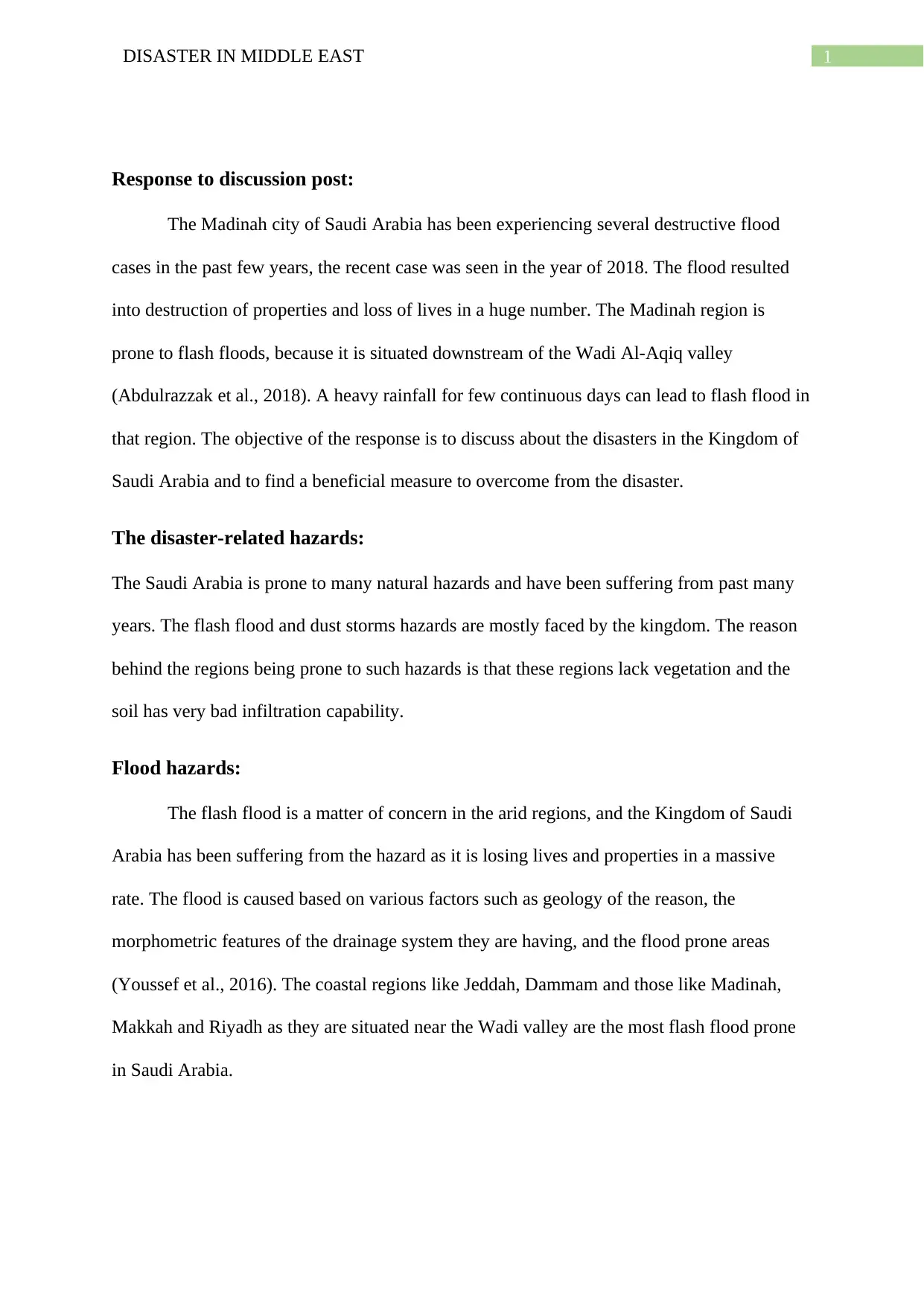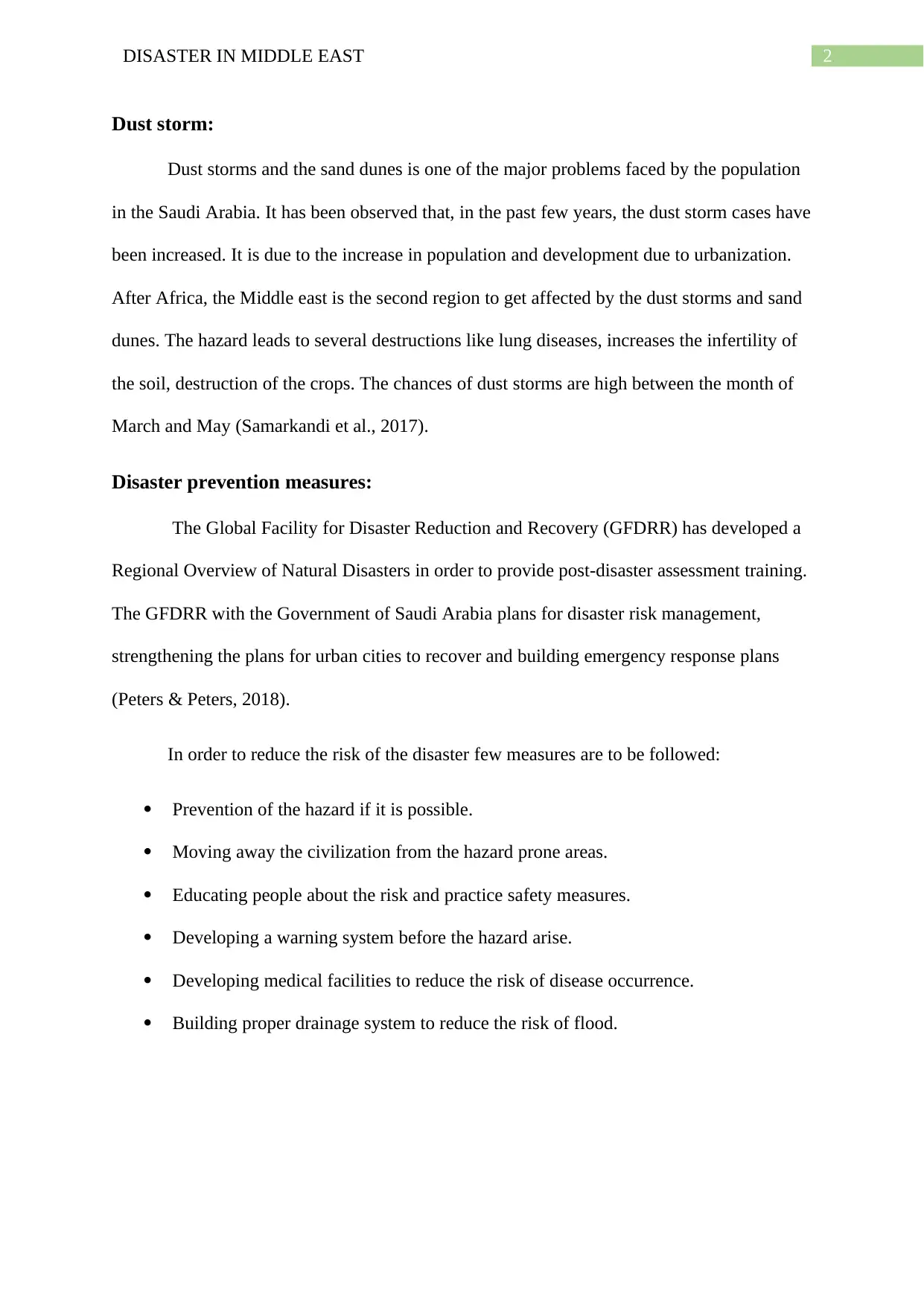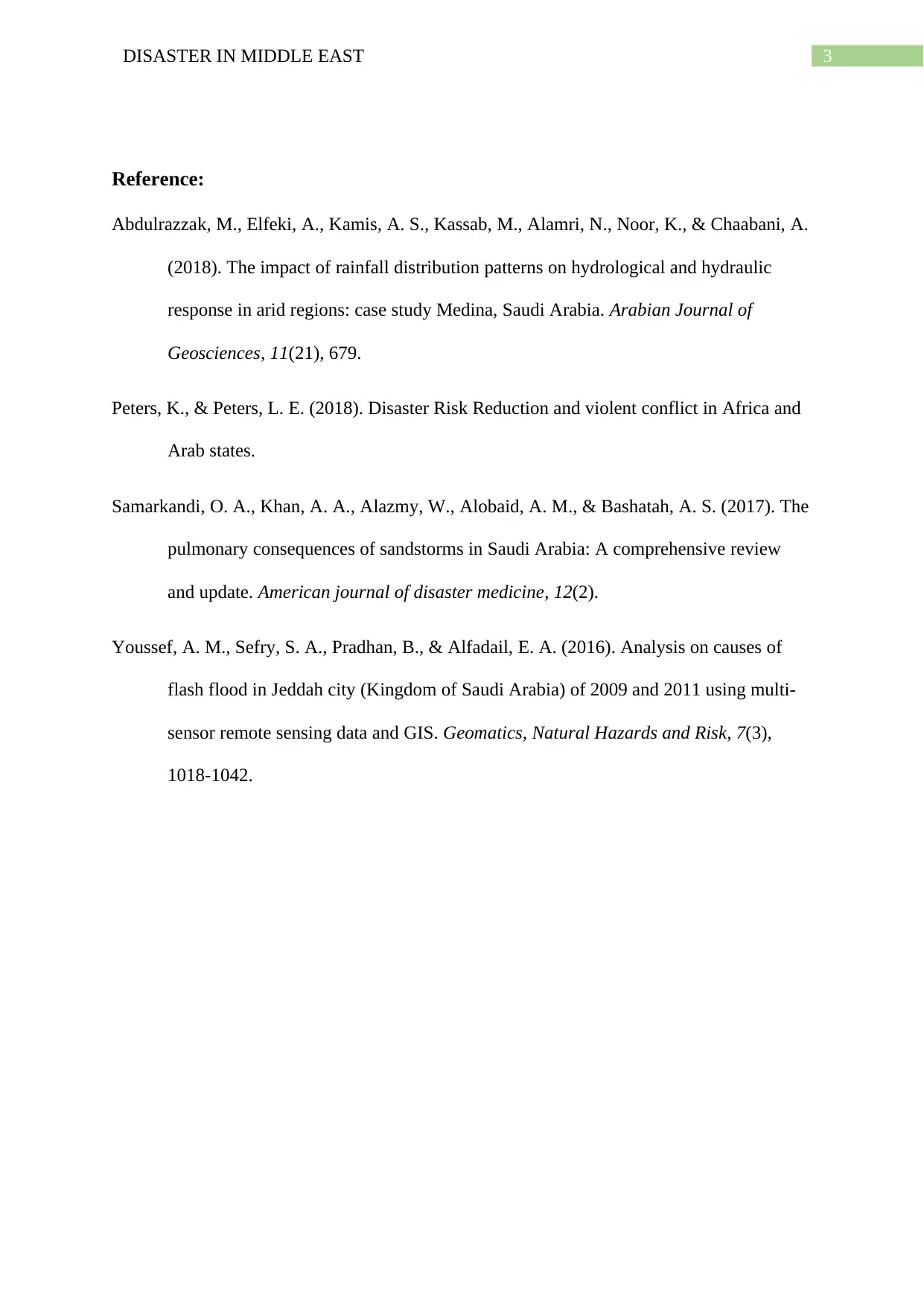Disaster in Middle East: Natural Hazards and Prevention Measures
VerifiedAdded on 2023/04/24
|4
|822
|490
AI Summary
This article discusses the natural hazards faced by the Kingdom of Saudi Arabia, including flash floods and dust storms, and suggests prevention measures to reduce the risk of disasters. It also highlights the efforts of the Global Facility for Disaster Reduction and Recovery (GFDRR) and the Government of Saudi Arabia in disaster risk management.
Contribute Materials
Your contribution can guide someone’s learning journey. Share your
documents today.

Running head: DISASTER IN MIDDLE EAST
DISASTER IN MIDDLE EAST
Name of the student:
Name of the university:
Author note:
DISASTER IN MIDDLE EAST
Name of the student:
Name of the university:
Author note:
Secure Best Marks with AI Grader
Need help grading? Try our AI Grader for instant feedback on your assignments.

1DISASTER IN MIDDLE EAST
Response to discussion post:
The Madinah city of Saudi Arabia has been experiencing several destructive flood
cases in the past few years, the recent case was seen in the year of 2018. The flood resulted
into destruction of properties and loss of lives in a huge number. The Madinah region is
prone to flash floods, because it is situated downstream of the Wadi Al-Aqiq valley
(Abdulrazzak et al., 2018). A heavy rainfall for few continuous days can lead to flash flood in
that region. The objective of the response is to discuss about the disasters in the Kingdom of
Saudi Arabia and to find a beneficial measure to overcome from the disaster.
The disaster-related hazards:
The Saudi Arabia is prone to many natural hazards and have been suffering from past many
years. The flash flood and dust storms hazards are mostly faced by the kingdom. The reason
behind the regions being prone to such hazards is that these regions lack vegetation and the
soil has very bad infiltration capability.
Flood hazards:
The flash flood is a matter of concern in the arid regions, and the Kingdom of Saudi
Arabia has been suffering from the hazard as it is losing lives and properties in a massive
rate. The flood is caused based on various factors such as geology of the reason, the
morphometric features of the drainage system they are having, and the flood prone areas
(Youssef et al., 2016). The coastal regions like Jeddah, Dammam and those like Madinah,
Makkah and Riyadh as they are situated near the Wadi valley are the most flash flood prone
in Saudi Arabia.
Response to discussion post:
The Madinah city of Saudi Arabia has been experiencing several destructive flood
cases in the past few years, the recent case was seen in the year of 2018. The flood resulted
into destruction of properties and loss of lives in a huge number. The Madinah region is
prone to flash floods, because it is situated downstream of the Wadi Al-Aqiq valley
(Abdulrazzak et al., 2018). A heavy rainfall for few continuous days can lead to flash flood in
that region. The objective of the response is to discuss about the disasters in the Kingdom of
Saudi Arabia and to find a beneficial measure to overcome from the disaster.
The disaster-related hazards:
The Saudi Arabia is prone to many natural hazards and have been suffering from past many
years. The flash flood and dust storms hazards are mostly faced by the kingdom. The reason
behind the regions being prone to such hazards is that these regions lack vegetation and the
soil has very bad infiltration capability.
Flood hazards:
The flash flood is a matter of concern in the arid regions, and the Kingdom of Saudi
Arabia has been suffering from the hazard as it is losing lives and properties in a massive
rate. The flood is caused based on various factors such as geology of the reason, the
morphometric features of the drainage system they are having, and the flood prone areas
(Youssef et al., 2016). The coastal regions like Jeddah, Dammam and those like Madinah,
Makkah and Riyadh as they are situated near the Wadi valley are the most flash flood prone
in Saudi Arabia.

2DISASTER IN MIDDLE EAST
Dust storm:
Dust storms and the sand dunes is one of the major problems faced by the population
in the Saudi Arabia. It has been observed that, in the past few years, the dust storm cases have
been increased. It is due to the increase in population and development due to urbanization.
After Africa, the Middle east is the second region to get affected by the dust storms and sand
dunes. The hazard leads to several destructions like lung diseases, increases the infertility of
the soil, destruction of the crops. The chances of dust storms are high between the month of
March and May (Samarkandi et al., 2017).
Disaster prevention measures:
The Global Facility for Disaster Reduction and Recovery (GFDRR) has developed a
Regional Overview of Natural Disasters in order to provide post-disaster assessment training.
The GFDRR with the Government of Saudi Arabia plans for disaster risk management,
strengthening the plans for urban cities to recover and building emergency response plans
(Peters & Peters, 2018).
In order to reduce the risk of the disaster few measures are to be followed:
Prevention of the hazard if it is possible.
Moving away the civilization from the hazard prone areas.
Educating people about the risk and practice safety measures.
Developing a warning system before the hazard arise.
Developing medical facilities to reduce the risk of disease occurrence.
Building proper drainage system to reduce the risk of flood.
Dust storm:
Dust storms and the sand dunes is one of the major problems faced by the population
in the Saudi Arabia. It has been observed that, in the past few years, the dust storm cases have
been increased. It is due to the increase in population and development due to urbanization.
After Africa, the Middle east is the second region to get affected by the dust storms and sand
dunes. The hazard leads to several destructions like lung diseases, increases the infertility of
the soil, destruction of the crops. The chances of dust storms are high between the month of
March and May (Samarkandi et al., 2017).
Disaster prevention measures:
The Global Facility for Disaster Reduction and Recovery (GFDRR) has developed a
Regional Overview of Natural Disasters in order to provide post-disaster assessment training.
The GFDRR with the Government of Saudi Arabia plans for disaster risk management,
strengthening the plans for urban cities to recover and building emergency response plans
(Peters & Peters, 2018).
In order to reduce the risk of the disaster few measures are to be followed:
Prevention of the hazard if it is possible.
Moving away the civilization from the hazard prone areas.
Educating people about the risk and practice safety measures.
Developing a warning system before the hazard arise.
Developing medical facilities to reduce the risk of disease occurrence.
Building proper drainage system to reduce the risk of flood.

3DISASTER IN MIDDLE EAST
Reference:
Abdulrazzak, M., Elfeki, A., Kamis, A. S., Kassab, M., Alamri, N., Noor, K., & Chaabani, A.
(2018). The impact of rainfall distribution patterns on hydrological and hydraulic
response in arid regions: case study Medina, Saudi Arabia. Arabian Journal of
Geosciences, 11(21), 679.
Peters, K., & Peters, L. E. (2018). Disaster Risk Reduction and violent conflict in Africa and
Arab states.
Samarkandi, O. A., Khan, A. A., Alazmy, W., Alobaid, A. M., & Bashatah, A. S. (2017). The
pulmonary consequences of sandstorms in Saudi Arabia: A comprehensive review
and update. American journal of disaster medicine, 12(2).
Youssef, A. M., Sefry, S. A., Pradhan, B., & Alfadail, E. A. (2016). Analysis on causes of
flash flood in Jeddah city (Kingdom of Saudi Arabia) of 2009 and 2011 using multi-
sensor remote sensing data and GIS. Geomatics, Natural Hazards and Risk, 7(3),
1018-1042.
Reference:
Abdulrazzak, M., Elfeki, A., Kamis, A. S., Kassab, M., Alamri, N., Noor, K., & Chaabani, A.
(2018). The impact of rainfall distribution patterns on hydrological and hydraulic
response in arid regions: case study Medina, Saudi Arabia. Arabian Journal of
Geosciences, 11(21), 679.
Peters, K., & Peters, L. E. (2018). Disaster Risk Reduction and violent conflict in Africa and
Arab states.
Samarkandi, O. A., Khan, A. A., Alazmy, W., Alobaid, A. M., & Bashatah, A. S. (2017). The
pulmonary consequences of sandstorms in Saudi Arabia: A comprehensive review
and update. American journal of disaster medicine, 12(2).
Youssef, A. M., Sefry, S. A., Pradhan, B., & Alfadail, E. A. (2016). Analysis on causes of
flash flood in Jeddah city (Kingdom of Saudi Arabia) of 2009 and 2011 using multi-
sensor remote sensing data and GIS. Geomatics, Natural Hazards and Risk, 7(3),
1018-1042.
1 out of 4
Your All-in-One AI-Powered Toolkit for Academic Success.
+13062052269
info@desklib.com
Available 24*7 on WhatsApp / Email
![[object Object]](/_next/static/media/star-bottom.7253800d.svg)
Unlock your academic potential
© 2024 | Zucol Services PVT LTD | All rights reserved.
